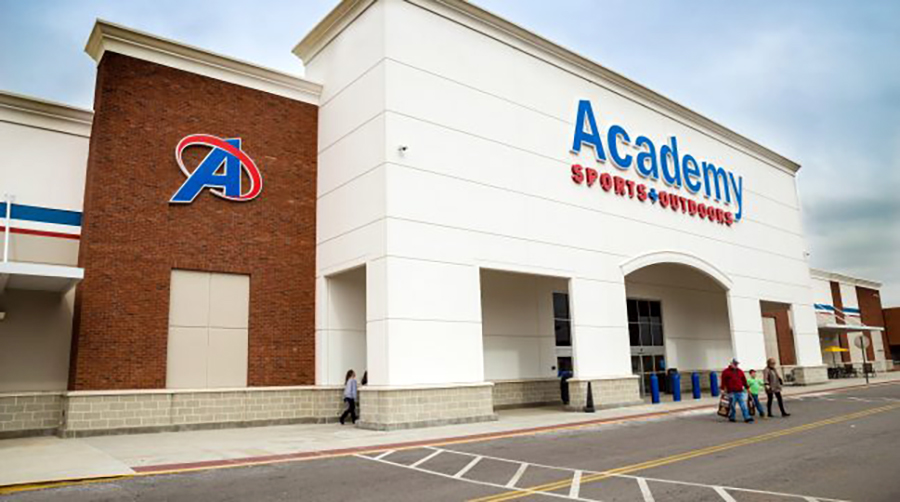Academy Sports and Outdoors, Inc. said a slow start to fall selling due to warmer temperatures and continued weak consumer demand caused the retailer’s third-quarter results to miss plan, resulting in a downward revision to full-year guidance.
CEO Steve Lawrence said on an analyst call, “We feel like we don’t have a challenged strategy. We’ve got a challenged customer.”
Shares of Academy in late-afternoon trading on Thursday were up slightly on the New York Stock Exchange despite the shortfall. Lawrence said the “much warmer than average temperatures” that arrived in September into early October “weighed on sales in fall seasonal categories,” particularly apparel and footwear. The warm weather also impacted gross margins as softer sales were seen in high-margin fall seasonal products while “customers instead gravitated towards our lower-margin summer clearance.”
However, Lawrence said key themes driving restrained spending by consumers seen in the first two quarters of the year also continued in the third quarter.
 “The customer is clearly under pressure,” said Lawrence. “They’re being careful about when they decide to shop and how they want to spend their money.” He added, “We’ve also seen a continuation of the trend of customers coming in during the key shopping mall moments in the calendar and then retreating during the lulls. Another key theme continues to be customers looking to expand their buying power by focusing on the value offerings in our assortment, including private brand merchandise, the promotions that we run, or clearance events that take place at the end of each season. Similar to prior quarters of this year, we also continue to see customers gravitate towards new and innovative brands and items in our stores and online.”
“The customer is clearly under pressure,” said Lawrence. “They’re being careful about when they decide to shop and how they want to spend their money.” He added, “We’ve also seen a continuation of the trend of customers coming in during the key shopping mall moments in the calendar and then retreating during the lulls. Another key theme continues to be customers looking to expand their buying power by focusing on the value offerings in our assortment, including private brand merchandise, the promotions that we run, or clearance events that take place at the end of each season. Similar to prior quarters of this year, we also continue to see customers gravitate towards new and innovative brands and items in our stores and online.”
As a result of the third-quarter performance and fourth-quarter expectations, Academy now sees comps for the year declining in the range of 7.5 percent to 6.5 percent versus previous guidance in the range of 7.5 percent to 4.5 percent. At the start of the year, Academy had projected comps to be in the range of negative 2 percent to positive 1 percent.
Lawrence said the company had hoped to return to positive comps this year as spending patterns normalized after the pandemic. Comps declined 6.4 percent in 2022 after surging 18.9 percent in 2021 and 16.1 percent in 2020.
Earnings on an adjusted basis are now projected in the range of $7.05 to $7.20 ($7.13 at the midpoint) compared with prior guidance in the range of $6.95 to $7.65 ($7.30 at the midpoint). At the start of the year, Academy predicted EPS in the range of $7.00 to $7.75 ($7.35 at midpoint).
To manage the challenged climate in the short term, Lawrence said Academy will focus on “delivering value in a couple of different ways,” including its everyday-value pricing, promotions that the chain runs during key periods, and clearance events at the end of each season. At the same time, Academy is “delivering a steady diet of new brands and new ideas” as customers have shown to be receptive to newness.
Lawrence also hopes weaker categories, such as hunting, which saw a pickup in October, are stabilizing. Nonetheless, he said the sales recovery is largely tied to the consumer’s mindset. “I think the focus on value, newness and leaning into our initiatives longer term in terms of opening new stores, growing our dot.com to where it should be, and getting more productivity out of existing stores…We think all of those things are the key ingredients to return back to positive comps,” said Lawrence. “That being said, when the customers’ health turns around a little bit, we can’t determine.”
In the quarter ended October 28, sales fell 6.4 percent to $1.4 billion, falling short of analysts’ consensus estimate of $1.46 billion.
Comparable-store sales fell 8.0 percent on top of a decline of 7.2 percent a year ago, driven by an 8.1 percent drop in transactions partially offset by a slight increase in ticket size.
By month, August sales were down mid-single-digits with “good momentum early in the month,” supported by healthy back-to-school selling, according to Lawrence. September worsened to a decline of low-double digits due to the warm weather challenges and the lack of a natural shopping event on the calendar. October recovered to a mid-single-digit sales decline that Academy believed was driven by the combination of cooler temperatures and increased sales in its struggling outdoor business.
By category, the top-performing business was sports & recreation, which saw a sales decrease of 2.7 percent. Declines in fitness and bikes were partially offset by continued strength in outdoor cooking and furniture and in team sports.
Sales in the outdoor division, including hunt & fish, ran down 6.9 percent for the quarter. Lawrence said the outdoor category had experienced softness for the past few quarters, although the business picked up towards the end of October as hunting season started and the category anniversaried softer comps from the year-ago period.
Apparel and footwear businesses started strong during the back-to-school season but tapered off in September. Apparel sales were down 6.9 percent in the quarter, while footwear slumped 8.2 percent. Lawrence said, “We believe the primary drivers of soft business were caused by the above-average temperatures we experienced in September and early October, which tamped down demand for fall seasonal items.”
Consistent with overall sales performance, e-commerce “experienced pressure” during the quarter with online penetration declining to 9.4 percent from 9.5 percent in the prior-year quarter, Carl Ford, CFO, said on the call.
Gross margins eroded to 34.5 percent from 35.0 percent due to a 49-basis point decline in merchandise margins and an increase in planned promotions and a higher mix of clearance sales, higher overhead costs, lower vendor allowances, and a slight increase in shrink offset with savings on freight. Promotional activity for the quarter was in line with expectations.
Academy’s margins remain roughly 500 basis points above pre-pandemic levels that management attributes to the benefits of structural changes in operations over the past few years.
SG&A expenses increased to 24.7 percent of sales from 23.0 percent a year ago. Ford said that while Academy emphasized expense controls, “more than 100 percent” of the increase in SG&A was due to investments to support long-term growth initiatives such as store openings, omnichannel, supply chain and its new customer data platform.
Operating income fell 23.8 percent to $136.7 million from $179.5 million, with operating margins eroding to 9.8 percent from 12.0 percent a year ago.
Net income fell 24.1 percent to $100.0 million, or $1.31 a share, from $131.7 million, or $1.62, a year ago.
On an adjusted basis, earnings slid 23.1 percent to $104.7 million, our $1.38, from $136.2 million, or $1.67, the prior year, and 27 cents short of Wall Street’s consensus estimate of $1.65. Adjusted EBITDA slid 18.8 percent to $ 174.5 million from $214.9 million.
Adjusted earnings exclude non-cash charges related to equity-based compensation and reflect changes in the treatment of pre-opening expenses.
Inventories at the quarter’s close were about flat, down 0.2 percent. On a per-store basis, units declined 4 percent. Ford said, “We believe our current assortment and inventory level is appropriate to support the business.”
Addressing progress on long-term plans, Lawrence said five stores opened during the quarter and seven in November, completing its expansion goals for the year with 14 new stores. The CEO said, “As we open new locations, we continue to gain insights into what factors ensure a successful launch of a new store. We’re getting better with each grand opening.”
Lawrence said Academy continues to find the stores opening in legacy markets where Academy has “high brand awareness” are on track to meet or surpass sales targets, while stores opening in new markets tend to take longer to reach maturity. He said, “We need additional time and investment to build brand awareness.”
Lawrence said further analysis of traffic, ticket and conversion post-holiday selling would refine Academy’s plans for future store openings. In April of this year, Academy announced a goal to open 120 to 140 new stores by the end of 2027.
Online, a big win for Academy has been its partnership with Fanatics, which has more than doubled the chain’s online offering of fan merchandise. More SKUs are expected to be added as each league starts. Lawrence said, “Over time, our online offers will be significantly larger, allowing us to greatly expand our reach and help us service a much wider fan base.”
Academy’s website also continues to add new capabilities, including the recent addition of a buy-now, pay-later purchase option through Sezzle.
In marketing, Academy continues to fine-tune customer segmentation through its new customer data platform (CSD), focusing on improving customer identification and increasing engagement. Said Lawrence, “While we’ve just begun to leverage some of our new capabilities for this tool, our initial marketing tests yield some promising results.”
One test of a reactivation campaign with new CSD tools enabled Academy to increase the number of customers reached through e-mails by 25 percent. A small e-mail test targeting a discount sent to a subset of the best customers to drive frequency and spend resulted in continued growth beyond the initial blast. Said Lawrence, “We’ll be able to start scaling these learnings, and they will start moving the needle in 2024 and beyond.”
Finally, a new warehouse management system is ready for rollout to support store expansion efforts.
Looking ahead, Lawrence remained upbeat on holiday selling, noting that customers have shown they’re willing to shop in key moments and “there is no bigger moment than in the upcoming holiday season.”
“We’re off to a solid start in November,” added Lawrence. “As expected, we saw traffic patterns return to more normalized pre-pandemic patterns with much pull-forward demand during the early part of the month. We put together a strong set of promotions for Thanksgiving week and saw a strong reaction from the customer, yielding one of biggest Black Friday events ever.”
He noted that Academy still faces several weeks to determine the health of holiday sales.
“We have a strong promotional cadence supported by an aggressive marketing spend, which should help us deliver outstanding value to our customers,” said Lawrence. “Our inventory is in the best position we’ve been in over the past few years with a focus on the key giftable categories along with the new brands and innovative items customers have been voting for all year. I’ve been in all three of our DCs and a lot of our stores, and I can tell you the teams are ready and excited for customers this Christmas.”
Photos courtesy Academy
















